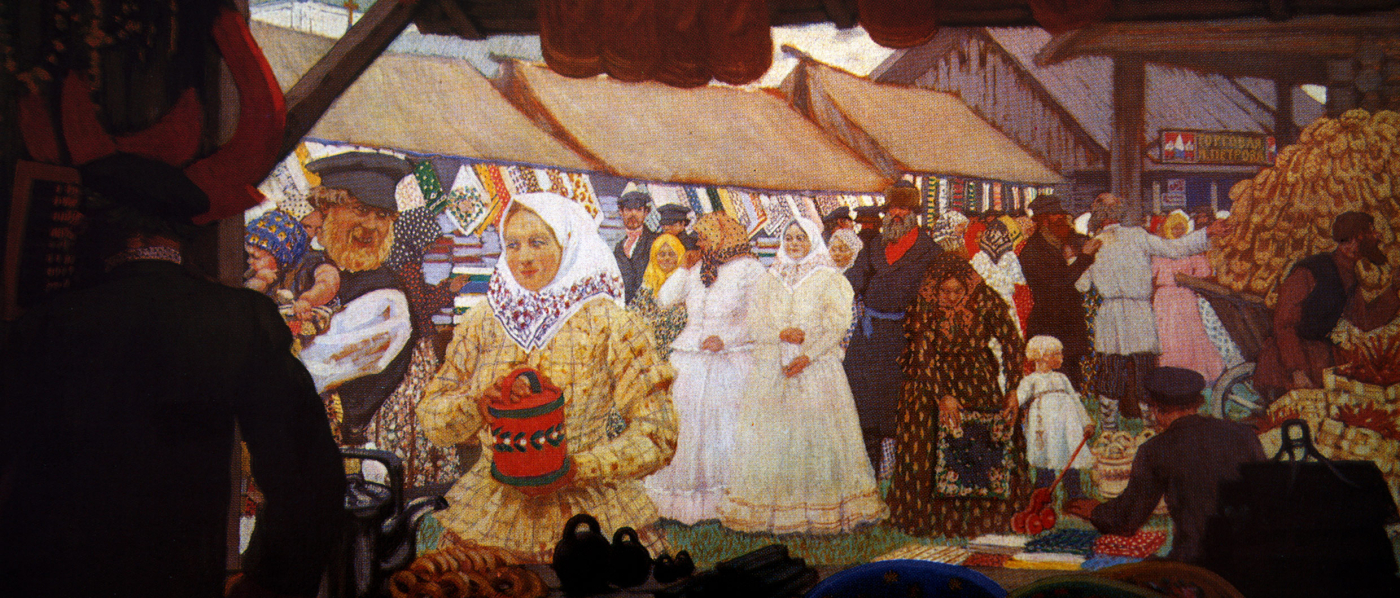Can institutions formed centuries ago influence current business activity? Is there any connection between the development of modern business and, for instance, pre-revolutionary business? These are not idle questions. To understand the possibilities for the conduct of economic policy, it is necessary to assess the influence of basic – i.e., slowly changing – parameters of the system and their sensitivity to events.
The catastrophic events and drastic changes in Russia’s 20th-century history – World Wars I and II, the 1917 Revolution and the Russian Civil War, and the collapse of the Soviet Union – each fundamentally transformed the country’s socio-economic system. Such radical disruptions were expected to completely change the geographical and other patterns of business activity of the population.
However, my study with Yulia Tsareva (RANEPA) shows that the current concentration of small business remains similar to the concentration of merchants, ‘nepmen’, Soviet trading companies and cooperative societies across Russian regions.
At first glance, the issue of identifying some stable historical and geographical patterns of business activity may seem questionable. Many businesses fold and many businesses start even over a single year, and management models have changed many times over the last century. For example, private entrepreneurship was mostly prohibited during the Soviet period of economic planning. However, we use an approach that involves the analysis of entrepreneurship as an economic phenomenon with its own temporal and geographical boundaries rather than a study of specific business units.
Institutional resilience
The effect of various forms of ‘path dependence’ is widely acknowledged in the social and economic literature. The experience of other countries shows that regional variations in entrepreneurial activity remain resilient to various shocks and transformations over centuries.
In Germany, for example, the level of entrepreneurial activity remains high in the same regions (Berlin, Bavaria, North Rhine-Westphalia, etc.) where it was elevated before World War II, even taking into account the differences between the Western and Eastern parts of the country (the former Federal Republic of Germany and the German Democratic Republic, respectively). In Poland, a positive correlation is observed between the level of knowledge-intensive entrepreneurship by region in the 1920s and current start-up activity, including the former German territories, where a large part of the population was relocated after World War II. The knowledge accumulated by regional communities over time may have stimulated the revival of modern technology businesses.
To assess the influence of historical institutions at the regional level in Russia, we collected and analysed historical data on the distribution of serfs, the establishment of universities, and business activity over a period of more than a century. In our study, ‘business activity’ refers to various direct and indirect estimates of the population’s involvement in entrepreneurship, such as the activities of merchants, nepmen, cooperatives, small businesses, etc.
Based on a literature review and an analysis of historical processes, we formulated and tested several hypotheses:
-
That certain extractive institutions of the pre-Soviet period, particularly serfdom (see the box above), have had a negative impact on the current level of entrepreneurship in Russian regions. The legacy of serfdom rooted in the culture and behavioural patterns of local communities may manifest in low entrepreneurial spirit and higher paternalism.
-
That an old university in a region has a positive impact on the business activity of the local population. The establishment of universities is generally viewed as a movement towards more inclusive economic institutions, as it helps involve more individuals in modern economic activities. Classical universities gradually formed a culture of exploration and transformation of the world around them, which is similar to the culture of creative entrepreneurship.
-
That the concentration of small enterprises (SEs) in Russian regions today is positively correlated with pre-revolutionary merchant business activity. The emergence of merchants may also be seen as a transition from extractive institutions to more inclusive institutions.
-
That there is no correlation between the geography of modern small trading companies and the location of trading companies in the Soviet period (due to the different principles of choosing locations in centrally planned or market economies).
-
That there is no influence of enforced entrepreneurship from periods of severe economic shock, such as after the Russian Civil War or the collapse of the Soviet Union, on the location of SEs today (because catastrophic shocks may distort the natural distribution of businesses and incentives for business activity).
Entrepreneurship: transmitting resilience
Our calculations support our first hypothesis: the higher the share of serfs in a region before the abolition of serfdom, the lower the concentration of small business today, other factors being equal.
However, this influence cannot be directly identified by a simple comparison of the two parameters. For example, the proportion of serfs was quite high in Nizhny Novgorod, Yaroslavl and Ryazan Regions, where the business activity of the population has historically been high, including during the pre-revolutionary period. In the Soviet period, horizontal mobility (transition between social groups) and vertical mobility (career advancement) were encouraged, and many enterprises were established in the cities and in undeveloped areas. Therefore, the correlation between serfdom and contemporary entrepreneurship under study only manifests when we use control variables to take into account the multiple changes in the social and economic conditions in Russia. Indicators such as GDP per capita, proximity to major markets for goods and services with high-quality human capital, and the unemployment rate were used as control variables.
In general, our second hypothesis (of a positive influence of university culture) is also confirmed by considering control variables.
A significant influence of universities on the development of entrepreneurial spirit is evident only for those higher educational institutions that were established before the Soviet period. Of the 20 regions where universities were created before the 1917 Revolution, 12 regions are leaders in business activity: Saint Petersburg, Moscow, Tatarstan; Tomsk, Nizhny Novgorod, Vologda, Samara, Sverdlovsk, Ryazan and Tyumen Regions, Primorye and Perm Territories. One possible explanation is that, during the Soviet period, higher educational institutions were mainly established to train engineers for Soviet industrial giants and construction projects and were unlikely to have had a significant influence on the emergence of entrepreneurial initiatives. In addition, it takes a long time and several generations of educated people for a culture to form, and the influence of relatively new universities on current business activity is therefore minimal. Low levels of business activity are observed where there are no universities.
Our third hypothesis (of a correlation between contemporary Russian small business and pre-revolutionary merchant activity) is partially confirmed. The relation is non-linear, but quadratic (U-shaped). The concentration of small business today is higher in regions where the share of merchants was either above or below average in the late 19th century.
One possible explanation is that there are regions which have a long-established culture of entrepreneurship and/or where similar business factors have been preserved and that such regions are leaders in both periods. These include the Moscow and Saint Petersburg metropolitan areas, Yaroslavl, Kostroma, Tver, Ryazan, and Smolensk Regions (traditional merchant centres and modern tourism), and Primorye and Khabarovsk Territories (foreign trade with China). There are also regions developed in the Soviet period where merchants had played a negligible role, but where favourable conditions for small business have emerged in the post-Soviet period. These regions include Sakhalin and Tyumen Regions (resource-rich centers with large consumer markets), Omsk Region, Novosibirsk Region, Voronezh Region, Chelyabinsk Region and Tatarstan (major cities with large markets). However, the concentration of small business in some traditional merchant centres, such as Orel, Tula, Bryansk, Vladimir and Novgorod Regions is currently below the national average. These regions suffered during the Great Patriotic War and lost a significant part of the local population. New Soviet manufacturing enterprises used a new workforce drawn from other regions of the USSR with no connection to the local pre-revolutionary culture.
Our fourth hypothesis (of a lack of correlation between the geography of Soviet-period trading enterprises and the geography of modern businesses) is partially confirmed. We note that the concentration of small business is now higher by 0.071 SEs per 1,000 persons in the labour force in the regions where the concentration of trading enterprises was higher by 1 enterprise per 1,000 members of the population before the Great Patriotic War (in 1940).
At the same time, no correlation was observed between modern entrepreneurship and the development of trade in the 1970s, because the plan-based management approach widely used after the retail cooperatives had been nationalised by 1970 led to significant changes in the regional distribution of trading companies. For example, the concentration of trading companies in Soviet Russia decreased from 2.8 in 1950 (during the post-war reconstruction period) to 2.27 in 1970 (during the period of developed socialism). The principles for determining the geographical location of trading companies in Soviet Russia could take state priorities into account, and the concentration of such companies was therefore higher in newly developed regions (Sakhalin, the Russian North, and Siberia), but lower in agricultural regions and major cities (Moscow, Leningrad, and Kuybyshev), where the need for diverse and numerous outlets of this kind was particularly high.
Our fifth hypothesis (of a lack of correlation between the current level of entrepreneurial activity and the level of enforced business activities from periods of social and economic shock) is confirmed only partially. This may be due to the fact that modern small business also emerged in the period of transformation, have faced many crises (in 1998, 2008, 2015, 2020, and 2022), and are linked to necessity as well. Moreover, during periods of drastic change, people are more likely to engage in enforced entrepreneurship in regions where the entrepreneurial spirit is generally stronger.
Overall, our hypothesis of the persistence (stability, resilience) of entrepreneurship in Russia can be considered confirmed. In other words, even with radical change in the political and economic systems, it is difficult to alter long-term underlying entrepreneurial trends, although they are undoubtedly impacted by political measures.
We have identified three main explanations, or three key channels, for the ‘transmission’ of resilience over decades and even centuries.
The geographical explanation is related to favourable external conditions (geography, natural resources, roads, etc.) in the areas where businesses are located. This results in benefits derived from the rebuilding of enterprises and/or the creation of similar enterprises in the area.
The functional explanation is linked to the traditional functions of the areas where industrial facilities are located. For example, many Soviet enterprises were established in the same places as pre-revolutionary businesses, including through nationalisation, and contemporary Russian enterprises were established on the basis of Soviet plants through privatisation.
The social and cultural explanation is connected to institutional factors and the established culture of local communities where entrepreneurship has become traditional and certain notions have been transmitted from one generation to another. This can involve the transmission of memories and certain practices and a focus by local communities on specific business functions.
It is not easy to determine which channel plays the most important role, as various regions are likely to have different combinations of these factors.
The full article is published in Voprosy Economiki, No. 7, 2023.







